
The shortlist for the Beazley Designs of the Year has been announced! Among the projects nominated are a hijab designed by Nike, the Olympic refugee flag, Kanye West's Life of Pablo merchandise and Ikea furniture that doesn't require tools for installation. The awards celebrate innovative, global design across six categories: Architecture, Digital, Fashion, Graphic, Product and Transport.
Projects shortlisted in the "Architecture" category are below and the full list of nominations can be seen here.

Mrs Fan's Plug-In House by People's Architecture Office
The Plugin House is built with a proprietary building renovation system developed as a result of the challenging context of Beijing hutong areas. The price of real estate in central Beijing makes owning a house difficult for many. However, the Plugin House costs 30 times less than a typical apartment. Plugin replaces part of a previously existing dwelling and adds new functions. These prefabricated modules incorporate insulation, interior and exterior finish into one moulded part.

Warke Water by Arturo Vittori
Warka Water is a vertical structure designed to harvest potable water from the atmosphere (it collects rain, harvests fog and dew). It relies only on gravity, condensation and evaporation and doesn’t require any electrical power. At a time when a quarter of the world’s population lacks access to safe drinking water, Warka Water tower is designed to harvest drinkable water from the atmosphere.
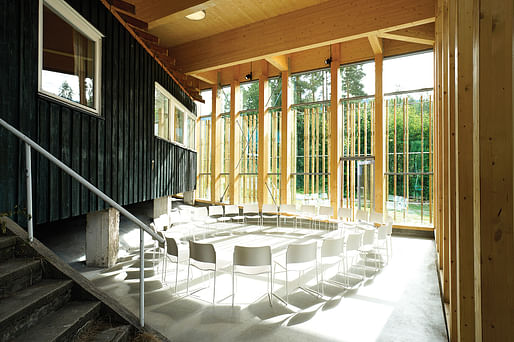
Hegnhuset, memorial and learning center on Utøya, Norway by Blakstad Haffner Architects
Response to Norwegian terrorist attacks of 2011 that struck the island of
Utøya, where 69 people – mostly teenagers – were murdered in one of two
politically motivated attacks by far-right terrorists. The cafe building where 13
people tragically lost their lives during the attack has been enshrined within
a new learning centre. The architect's response was to preserve one
section of the cabin-like building – the rooms directly affected during the
massacre – but to completely enclose it within a new pine structure. The
outer layer is made up of 495 wooden slats, one for every person on the
island that survived the attack, while the glazed inside layer is framed by 69
columns that pay tribute to every fatality.

Smithsonian National Museum of African American History and Culture in Washington D.C. by Adjaye Associates, the Freelon Group, Davis Brody Bond, SmithGroupJJR for the Smithsonian Institution
The museum was inaugurated by President Obama in September 2016 and is a long-awaited symbol for the African American contribution to the nation’s history and identity. The museum houses galleries, administrative spaces, theatre space and collections storage space. Sir David Adjaye’s approach created a meaningful relationship to this unique site as well as a strong conceptual resonance with America’s longstanding African heritage. The 313,000-square-foot building comprises a three-tiered structure covered in bronze plates. Designed to shade the glazed facades behind, the filigree cladding is patterned to reference the history of African American craftsmanship

Wind and Rain Bridge by Donn Holohan with students from the University of Hong Kong and Peitian Community Craftsmen
Wind and Rain Bridge draws on the long tradition of wooden buildings in the
region. Peitian is one of a number of isolated rural villages distributed
throughout the mountainous regions of southern China, which, following
severe flooding in early 2014 saw much of the infrastructure linking its
disparate communities destroyed. This project aims to reconnect Peitian
villages to the historic network of routes that link these isolated settlements.

Sala Beckett Theatre and International Drama Center by Flores & Prats
The project is a renovation and extension of the former worker’s club "Pau i Justícia", deeply rooted in the memory of the Barcelona neighborhood Poblenou, a space where long ago neighbors had celebrated marriages, first communions and parties, which was then abandoned for many years. The new building maintained the spatial characteristics of the original 8 building while also expanding and adapting the space to accommodate a new program of exhibitions and activities.

The Calais Builds Project by Gráinne Hassett with migrants living in the Calais Jungle and students of Architecture from the University of Limerick
The Calais Builds Project captured the needs, culture and hopes of its
residents. In 2016, architect Grainne Hassett along with students from the
University of Limerick and local migrants designed and built a major
community infrastructure, including a Women’s and Children’s Centre and
the Baloo’s Youth Centre. These were demolished in 2016 by the French
Government and its inhabitants displaced.
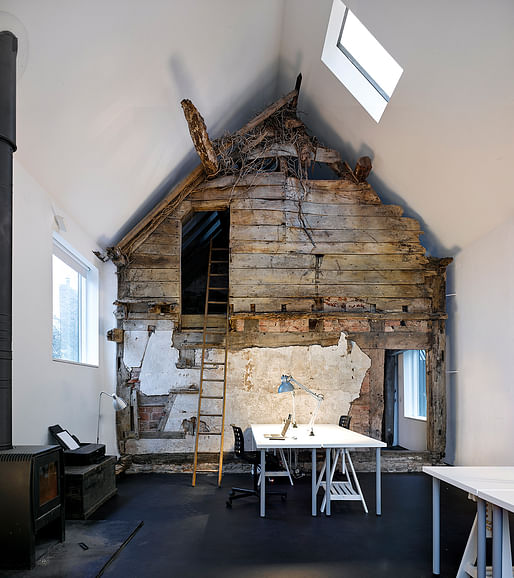
Croft Lodge Studio by Kate Darby Architects and David Connor Design
The strategy was not to renovate or repair the 300 year old listed building
but to preserve it perfectly. The ruin is protected from the elements within a
new high performance outer envelope. The new outer shell, which retains
the shape of the existing cottage is clad in black corrugated iron, reflecting
the common use of this material in Herefordshire for agricultural buildings.

Lycée Schorge Secondary School by Kéré Archiecture
Located in the third most populated city in Burkina Faso, the Lycée Schorge
Secondary School sets a new standard for educational excellence in the
region. The design for the school consists of 9 modules which
accommodate a series of classrooms and administration rooms in a radial
layout which wrap around a central public courtyard. The architecture not
only functions as a marker in the landscape, it is also a testament to how
local materials, in combination with creativity and team‑work, can be
transformed into something significant with lasting effects.

Weltsadt-Refugees' Memories and Futures as Models by Schlesische27 International Youth, Arts and Culture Center in collaboration with Raumlaborberlin and the SRH Hochschule der Populären Künste – hdpk
The exhibition features models of buildings made by people from Africa and the Middle East who came to Germany as refugees. The buildings are homes, schools, offices, workshops and houses of prayer which are displayed as a walk-through cityscape, a 'world city'. Made of cardboard, wood and found materials, the models reflect on the lost spaces and trusted 9 memories but equally of new beginnings of the people who build the models. Visitors can see each of the 1:10 scale buildings up close.
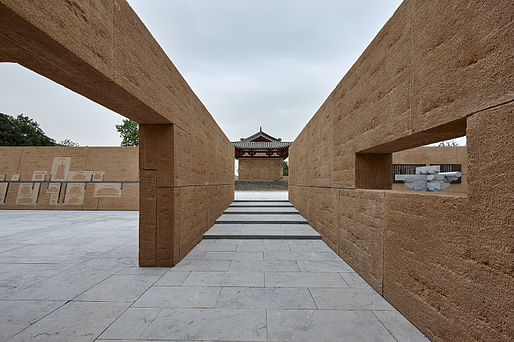
The Environmental Enhancement of the Five Dragons Temple by Urbanus
Situated in Ruicheng County, Shanxi Province, the Five Dragons Temple is listed as a class A cultural relic. Built in 831 A.D. during the Tang Dynasty, it is the oldest surviving Taoist temple. In 2015, Vanke Group initiated the "Long Plan" to raise funds to revitalise the environment of the Five Dragons Temple. This plan also helped to raise the public awareness of this historical preservation project. This initiative would then go on to become the first time where the government and private funds cooperated for the preservation of cultural relics, as well as the promotion of cultural protection through the platforms of internet and the international Expo.
Port House (pictured above) by Zaha Hadid Architects
The new Port House in Antwerp repurposes, renovates and extends a derelict fire station into a new headquarters for the port – bringing together the port’s 500 staff that previously worked in separate buildings around the city. The waterside site offered sustainable construction benefits, allowing materials and building components to be transported by water, an important requirement to meet the port’s ecological targets. The old fire station is heritage listed so had to be integrated into the new project. ZHA’s design is an elevated extension, rather than a neighboring volume which would have concealed at least one of the existing facades.
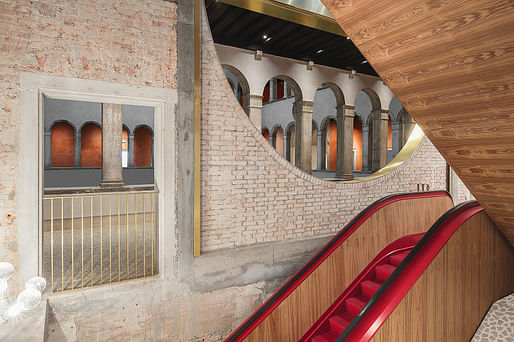
Il Fondaco Tedeschi, Venice by OMA
First constructed in 1228, and located at the foot of the Rialto Bridge across from the fish market, the Fondaco dei Tedeschi is one of Venice’s largest and most recognizable buildings. It was used as a trading post for German merchants, a customs house under Napoleon, and a post office under Mussolini. Depicted by Canaletto and other masters, and photographed countless times as the impressive but anonymous backdrop of the Rialto bridge, the Fondaco stands as a mute witness of the Venetian mercantile era, its role diminished with the progressive depopulation of Venice. The Fondaco dei Tedeschi can now unlock its potential as a major destination and vantage point for tourists and Venetians alike; a contemporary urban department store staging a diverse range of activities, from shopping to cultural events, social gatherings and everyday life. OMA’s renovation, both 10 subtle and ambitious, avoids nostalgic reconstructions of the past and it demystifies the ‘sacred’ image of a historical building.

Kinderspace: Architecture for Children's Development #2
Register by Thu, Jan 16, 2025
Submit by Mon, Jun 16, 2025

Land Art Generator Initiative 2025 Fiji: Climate Resilience for Island Communities
Register/Submit by Mon, May 5, 2025
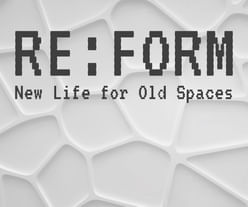
Re:Form – New Life for Old Spaces
Register by Wed, Jan 22, 2025
Submit by Tue, Sep 2, 2025

The Last Nuclear Bomb Memorial / Edition #5
Register by Thu, Jan 16, 2025
Submit by Wed, Feb 19, 2025
No Comments